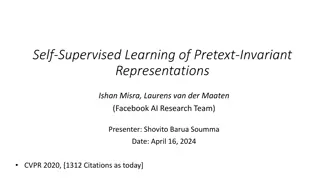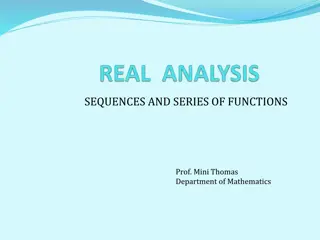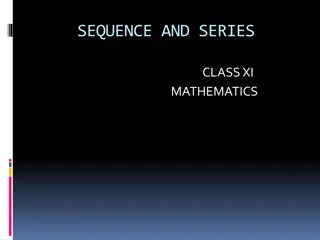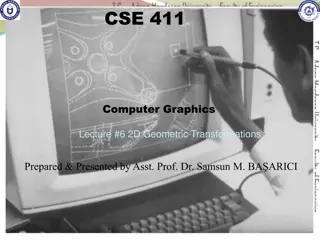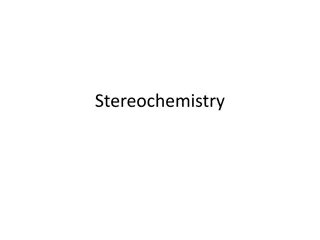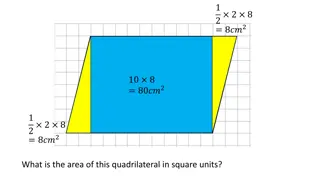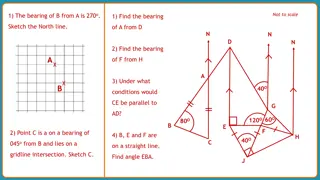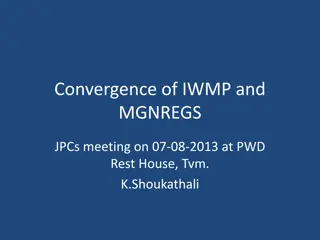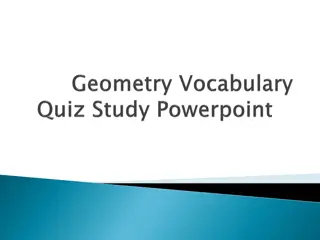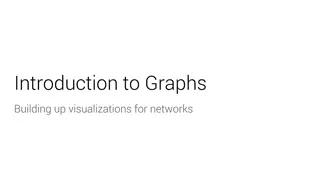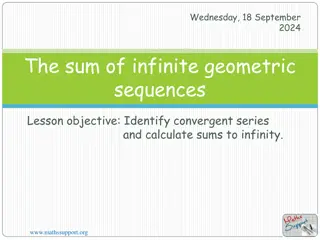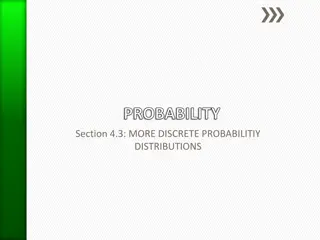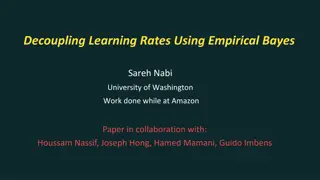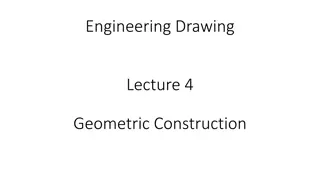Geometric Series: Power Series Representations & Convergence
Geometric series analysis discusses the summation, convergence, and divergent properties within and outside the unit circle. The series' representation, convergence conditions, and extensions are explored through power series expansions and geometric series summations, providing a comprehensive understanding of their applications.
Download Presentation

Please find below an Image/Link to download the presentation.
The content on the website is provided AS IS for your information and personal use only. It may not be sold, licensed, or shared on other websites without obtaining consent from the author.If you encounter any issues during the download, it is possible that the publisher has removed the file from their server.
You are allowed to download the files provided on this website for personal or commercial use, subject to the condition that they are used lawfully. All files are the property of their respective owners.
The content on the website is provided AS IS for your information and personal use only. It may not be sold, licensed, or shared on other websites without obtaining consent from the author.
E N D
Presentation Transcript
b z Analytic a z ECE 6382 0 z a b z z z 0 Fall 2023 David R. Jackson Notes 7 Power Series Representations Notes are from D. R. Wilton, Dept. of ECE 1
Geometric Series Consider the following sum: Consider S N = Geometric series (GS): 2 N n = + + + + 1 z z z z N = 0 n 2 n = = + + + 1 S z z z Note that = 0 n + 2 1 N N = + + + + zS z z z z N Hence, we have ( ) + 1 N = = 1 1 S zS z S z N N N + 1 N 1 z = S N 1 z ( ) 1 + + + + i N N 1 1 1 N N N = = = iff 0 1 z r e r r z Note: 2
Geometric Series (cont.) Hence, we have: y 1 2 n = + + + = , 1 1 z z z z z 1 1 z = 0 n z 1 (summation of geometric series) x 1 1 We can write this as: Complex plane for f (z) 1=1 z ( ) f z + + + 2 , 1 z z z 1 (a power series expansion of the function f (z)) The power series for f (z) converges inside the unit circle and diverges outside the unit circle. It oscillates (does not converge) on the unit circle. 3
Geometric Series (cont.) For |z| > 1 we can use another series representation: GS 1 1 1 z 1 z 1 1 z = = + + + 1 ( ) 2 3 1 z 1 z 1 z z 1 z 1 1 z = 2 3 z This is the geometric series with z 1/z. y This series converges iff z 1 1 z i.e., 1 1 , z z 1 x 1 1 4
Geometric Series (cont.) y Summary of Geometric Series Results Consider z 1 z 1 1 x 2 n = + + + = , 1 1 z z z z 1 z 1 = 0 n 1 (Geometric series) 1 1 z 1 z 1 z 1 z 1 z n = + + + = , 1 1 z z 2 3 1 z = 0 n This is an extension (or continuation ) of the original geometric series. The geometric series is important by itself, and it is also useful for later derivations. 5
Geometric Series (cont.) Generalize: (pole at zp): Consider 1 z 2 3 1 1 z z z z z = = + + + + if , i.e. 1 1 z z p z z z z z z p p p p p p 1 z p z p y z z p z p z z p x Taylor series Laurent series R 2 3 z z z z 1 z 1 11 z p p p p = = + + + + if , i.e. 1 z z p z z z z z z p p 1 z z 6
Geometric Series (cont.) The previous series were expanded about the origin. We can also expand about another point. 2 3 + z z z z z z 1 z 1 1 1 0 z 0 z 0 z = = = + + + 1 ) ( ) ( ) ( Consider p z z z z z z z z z z z z ( ) 0 0 0 p p p 0 0 0 p p 0 z 1 z z 0 p z 0 p z z z z z z 0 0 p 0 z Valid if , i.e. 1 z z z z 0 0 p z This is the case illustrated here. y 0 p z z p 0z R z z 0 Decide whether |zp-z0| or |z-z0| is larger (i.e., if z is inside or outside the circle at right), and then factor out the term with largest magnitude! z z 0 p Radius of convergence : z z = R 0 p x Similarly, 2 3 + z z z z z z 1 z 1 1 1 0 0 0 p p p = = = + + + 1 ) ( ) ( ) ( z z z z z z z z z z z z z z z ( ) 0 p 0 0 0 0 p 0 0 p 1 z z 0 z z 0 z z 0 p Valid if , i.e. 1 z z z z 0 0 p z z 0 7
Geometric Series (cont.) Summary of Series 2 3 Consider = 1 z 1 z z z z z z + + + + 0 z 0 z 0 z if 1 z z z z ( ) 0 0 p z z z z z z 0 0 0 p p p p 0 p Taylor series y Converges inside circle z p 0z x Converges outside circle Laurent series 2 3 z z z z z z 1 z 1 0 0 0 p p p = + + + + if 1 z z z z ( ) 0 0 p z z z z z z z z z 0 0 0 0 p 8
Uniform Convergence 1 2 z= + + + 1 1 z z , z 1 Consider Let's evaluate the geometric series for 3 2 1 = + + + . 10 0 10 i , 0 10 i , 0 z i 3 = + : 10 0 z i 1 = + 0 001 0 000001 0 000000001 . . + + + 1 00 . . 3 1 10 = 1 001001001001001 . Clearly, every additional term adds 3 more significant figure s to the final result. 2 = + : 10 0 z i 1 = + 0 01 0 0001 0 000001 . . + + + 1 00 . . 2 1 10 = 1 0101010101 . Here, however, each additional term adds only 2 more significant figures to the result. 1 = + : 10 0 z i 1 = + 0 1 0 01 . + + + 1 00 . 0 001 . . 1 1 10 = 1 11111 . And here each additional term adds only 1 more significant figure to the result. In general, for a given accuracy, the number of terms needed increases as |z| get larger and approaches 1. The series is said to converge non-uniformly in the region |z| < 1. 9
Uniform Convergence (cont.) ( ) f z ( ) z = uniformly convergent A series is in a region if for any R g n = 0 n , independent of , there exists a number , dependent on but in the region 0 N z N ( ) f z ( ) z ll in R . such that implies for a N N g z n = 0 n 1 2 3 The series converges slower and slower as |z| approaches 1. z= + + + + 1 z z z 1 y y z 1 1 z R 1 R x x 1 1 Non-uniform convergence Uniform convergence Key Point: Term-by-term integration of a series (switching the order of summation and integration) is allowed over any region where it is uniformly convergent. We use this property extensively later! 10
Uniform Convergence (cont.) 1 2 3 = = + + + + 1 1 S z z z , z Example 1 z Consider + 1 N 1 z 2 N = + + + + = 1 S z z z N 1 z + 1 N 1 1 1 z + + 1 1 N N = = = = The partial sum error is S S e z S z N N 1 1 1 z z z S S + 1 N = = N The relative error is z rel S Note: A relative error of 10-p means p significant figures of accuracy. Number of geometric series terms N vs. |z| Number of terms N needed in series vs. |z| 500 400 2 sig. digits 4 sig. digits 6 sig. digits 8 sig. digits 10 sig. digits The closer z gets to the boundary of the circle, the more terms we need to get the same level of accuracy (non-uniform convergence). 300 N N 200 100 0 0 0.2 0.4 0.6 0.8 1 |z| |z| 11
Uniform Convergence (cont.) Assume: Example (cont.) 1 z R Consider S S + 1 N + 1 N = = N The relative error is z R rel S For example: Number of geometric series terms N vs. |z| Number of terms N needed in series vs. |z| = 0 95 . R 500 N10 N8 N6 N4 N2 450 + ( ) 1 N + 1 N = 0 95 . R 400 rel 2 sig. digits 350 4 sig. digits 300 N N 250 6 sig. digits 200 8 sig. digits y 150 10 sig. digits 100 50 0 1 z R 0.95 0 0.2 0.4 0.6 0.8 1 |z| |z| R x 1 UsingN = 350 will give 8 significant figures everywhere inside the region. We now have uniform convergence for R = 0.95. 12
Uniform Convergence (cont.) Example z 1 Consider 1 dz, z R 1 z 0 z z z 1 n n = = dz z dz z dz 1 z = = 0 0 n n 0 0 0 Switch the order of integration and summation (integrate term-by-term) Hence, we have z + 1 2 3 n y 1 z n z z = = + + + dz z + 1 1 2 3 z = 0 n 0 1 z R R Note: This is not valid for |z| 1. x 1 (We do not have uniform convergence there.) 13
The Taylor Series Expansion This expansion assumes we have a function f(z) that is analytic in a disk. Consider Summary of Taylor Series: ( ) ( ) f z n = a z z z z R Analytic 0 c 0 n = 0 n C 0z z z 0 ( ) f z z 1 = a dz z n + ( ) 1 n R 2 i z c C 0 sz ( ) ! n ( ) n f z 0 = a derivative formula n Here zs is the closest singularity to z0. The path C is any counterclockwise closed path within the disk that encircles the point z0. Note: Both forms are useful. Rc = radius of convergence of the Taylor series (distance to closest singularity) The Taylor series will converge within the radius of convergence and diverge outside. 14
The Taylor Series Expansion (cont.) BTaylor.jpg Taylor's theorem is named after the mathematician Brook Taylor, who stated a version of it in 1712. Yet an explicit expression of the error was not provided until much later on by Joseph- Louis Lagrange. An earlier version of the result was already mentioned in 1671 by James Gregory. Brook Taylor (1685-1731) From Wikipedia 15
The Laurent Series Expansion (cont.) Review of Cauchy s Integral Formula (from Notes 3): ( ) f z z 1 ( ) f z = dz 0 2 i z 0 C Another way to write it: ( ) f z z 1 ( ) f z = dz 2 i z C Take derivative n times. ( ) f z z ! n ( ) ( ) n = f z dz 0 + ( ) 1 n 2 i z C 0 16
Taylor Series Expansion of an Analytic Function (cont.) f is analytic inside R Write the Cauchy integral formula in the form y ( ) f z z 1 ( ) ( ) f z sz singularity = dz 2 i z C z ( ) ) ( ( ) f z f z 1 z = dz z z ( ) 0 2 i z z z z 0 0 C 0z z z 0 1 C = ( ) dz z z z z 0 0 2 i z z z z ( ) 0 1 z z C 0 R 0 n ( ) f z z 1 z z z z = 0 dz ( ) 2 i z = 0 0 0 n C x conv uniform ergence ( ) f z z Construct circle C so that 1 ( ) n = z z dz 0 + ( ) 1 n 2 i z z z z z z z = 0 n 0 C 0 0 0 s derivative formulas ( ) ! n ( ) f z z ( ) n f z ! n ( ) ( ) z n ( ) n 0 = = recall z z f dz 0 0 + ( ) 1 n 2 i z = 0 n 0 C ( ) ( ) f z ( ) f z n = Taylor series expansion of about a z z z 0 0 n = 0 n where ( ) ! n ( ) f z z ( ) n f z 1 0 = = a dz n + ( ) 1 n 2 i z 0 C 17
Taylor Series Expansion of an Analytic Function (cont.) Note that in the result for an, the integrand is analytic inside from z0, and hence (from Cauchy s theorem) the path C is now arbitrary, as long as it encircles z0 and stays inside . The point z can even be outside the path C (see the note below). away y sz z z z 0 z 0z C z z 0 ( ) f z z 1 = a dz n + ( ) 1 n 2 i z R C 0 (Note: This integral does not have z in it.) x ; t s Note that the result is valid for any where is the singularity nearest z z z hence z z 0 0 e s h e r e i wil s l c o n v e r g e i f z 0 s z z z z 0 0 s z z z z Note: It can also be shown that the series will diverge for 0 0 s 18
Taylor Series Expansion of an Analytic Function (cont.) The radius of convergence of a Taylor series is the distance out to the closest singularity. y sz Key point: The point z0 about which the expansion is made is arbitrary, but It determines the region of convergence of the Taylor series. R c 0z x Converges for : z z R z z 0 0 c s 19
Taylor Series Expansion of an Analytic Function (cont.) Properties of Taylor Series Rc = radius of convergence = distance to closest singularity A Taylor series will converge for |z-z0| < Rc(i.e., inside the radius of convergence). A Taylor series will diverge for |z-z0| > Rc(i.e., outside the radius of convergence). A Taylor series converges uniformlyfor |z-z0| R < Rc. A Taylor series may be differentiated or integrated term-by-term within the radius of convergence. This does not change the radius of convergence. A Taylor series converges absolutely inside the radius of convergence (i.e., the series of absolute values converges). Within the common region of convergence, we can add and multiply Taylor series, collecting terms to find the resulting Taylor series. When a Taylor series converges, the resulting function is an analytic function. J. W. Brown and R. V. Churchill, Complex Variables and Applications, 9th Ed., McGraw-Hill, 2013. 20
The Laurent Series Expansion This generalizes the concept of a Taylor series to include cases where the function is analytic in anannulus. Consider a z z b 0 Final Result: bz Analytic az ( ) ( ) f z n = a z z 0 n 0z = n a or 1 ( ) ( ) f z n = + b a z z b 0 n n ( ) z z n z z z 0 = = 0 1 n n 0 = where b a n n ( ) f z z 1 Here za and zb are two singularities. = a dz (derived later) n + ( ) 1 n 2 i z Note: C 0 The point za may be the point z0. The point zb may be at infinity. (This is the same formula as for the Taylor series, but with negative n allowed.) The path C is any counterclockwise closed path that stays inside the annulus and encircles the point z0. Note:We no longer have the derivative formula as we do for a Taylor series. 21
The Laurent Series Expansion (cont.) Consider Summary of Laurent series: bz ( ) Analytic ( ) f z n = a z z 0 n az = n 0z a ( ) f z z 1 = a dz b n + ( ) 1 n 2 i z z z z C 0 0 The Laurent series converges inside the region a z z b 0 The Laurent series diverges outside this region if there are singularities at = z z a b. and 0 22
The Laurent Series Expansion (cont.) Pierre Alphonse Laurent.jpeg The Laurent series was named after and first published by Pierre Alphonse Laurent in 1843. Karl Weierstrass may have discovered it first in a paper written in 1841, but it was not published until after his death. Pierre Alphonse Laurent (1813 -1854) From Wikipedia 23
The Laurent Series Expansion (cont.) The Laurent series is particularly useful for functions that have poles. Consider Examples of functions with poles, and how we can choose a Laurent series: b z Analytic a z 0 z 1 z ( ) ( ) f z = = = a 0: 0 z a , b Choose 0 b z z z 0 y z R : 0 x 24
The Laurent Series Expansion (cont.) b z Analytic Consider Examples of functions with poles, and how we can choose a Laurent series: a z 0 z a b z z z z 0 ( ) ( ) f z = = = 0: 1 z a ,b Choose 0 1 z z ( ) ( ) f z = = = 1: 0 z a ,b Choose 0 1 z y y z R : 1 z R : 1 0 1 x x 1 25
The Laurent Series Expansion (cont.) b z Analytic Examples of functions with poles, and how we can a z Consider choose a Laurent series: 0 z a b z z z 0 z ( ) ( ) f z = = = = 0: 1 2 z a ,b Choose ( )( ) 0 1 2 z z z ( ) ( ) f z = = = 0: 2 z a ,b Choose ( )( ) 0 1 2 z z y R : 1 2 z y x 2 1 x 2 1 z R : 2 26
The Laurent Series Expansion (cont.) Example: The singularity does not have to be a pole. z ( ) ( ) f z = = = = 2: 3 4 z a , b Choose )( ) 0 1 2 / ( 2 2 1 z z z = 2 0 ( ) = = 2: 4 z a ,b or choose 0 y y Choose alternative branch cut. Branch cut Branch cut Pole Pole 1 x 1 x 2 1 2 2 1 2 R : 3 2 4 z z R : 2 4 27
The Laurent Series Expansion (cont.) Theorem: The Laurent series expansion in the annulus region is unique. Consider y (So it doesn t matter how we get it; once we obtain it by any series of valid steps, it is correct!) This is justified by our Laurent series expansion formula, derived later. z R : 0 z = 0 Example: a 0 ( ) z z x cos ( ) ( ) f z = = = 0 0 z , a , b 0 b analytic for valid for z 0 z 2 4 6 1 z z z z ( ) f z = + + 1 2! 4! 6! 3 5 1 z z z z ( ) f z = + 0 , z Hence 2! 4! 6! 28
The Laurent Series Expansion (cont.) A Taylor series is a special case of a Laurent series. Consider Laurent series: ( ) ( ) f z n = a z z 0 n = C n 0z ( ) f z z 1 = a dz n + ( ) 1 n 2 i z C 0 If f (z) is analytic: = 1 2 3 , = 0 n a , n , Here f is assumed to be analytic within C. If f (z) is analytic within C, the integrand is analytic for negative values of n. Hence, all coefficients an for negative nbecome zero (by Cauchy s theorem). 29
The Laurent Series Expansion (cont.) Derivation of Laurent Series We use the bridge principle again Pond, island, & bridge Pond: Domain of analyticity Island: Region containing singularities Bridge: Region connecting island and boundary of pond 30
The Laurent Series Expansion (cont.) y Annulus (between C1 and C2) Contributions from the paths c1 Consider andc2cancel! f is analytic in z 2c R z 1c The point z is between C1 and C2. 1 sz By Cauchy's Integral Formula, z 0 ( ) f z z 1 z ( ) f z C = dz C 2 1 2 i z + C c 2 c C 2 1 1 sz ( ) f z z ( ) f z z 2 1 1 = + C C c C c = dz dz 2 1 1 2 2 2 i z i z x C C 2 1 , , On C z z z z 2 0 0 ( ( ) ) ( z ) n n n z z z z 1 1 1 1 0 0 = = = = ( ) ( ) + ( ) 1 n z z z z z z z z z z z z z z z ( ) = = 0 0 0 0 0 n n 0 1 z z 0 0 0 0 , On C z z z z (note the convergence regions for ove rlap!) C ,C 1 0 0 1 2 = 1 n n , ( ) n ( z ) n n n n n z z z z 1 1 1 0 0 = = = ( ) ( ) + + ( ) ( ) 1 1 z z z z z z z z z z z z z ( ) = = 0 0 0 1 n n 0 1 z z 0 0 0 31 0
The Laurent Series Expansion (cont.) y Consider 1 2 i Hence, ( ) f z z ( ) f z = dz z z R + C c 2 c C 2 1 1 uniform convergence z 1 sz ( ) f z z z 1 ( ) n 0 = z z dz 0 + ( ) 1 n 2 i z = 0 n C 0 C C 2 2 1 ( ) f z z 1 ( ) n sz z z dz 2 0 + ( ) 1 n 2 i z = 1 n 0 C 1 x Note: The integrands are analytic in the blue region. Because the integrands for the coefficient are analytic with (the blue region), the paths are arbitrary, as long as they stay within . We can use the same path C, which is arbitrary as long as it stays within . 32
The Laurent Series Expansion (cont.) y Consider ( ) f z z 1 z ( ) ( ) f z n = z z dz 0 + ( ) 1 n 2 i z = 0 n C 0 z ( ) f z z 1 sz z 1 ( ) n 0 + z z dz 0 + ( ) 1 n 2 i z = 1 n C 0 R C sz 2 x We thus have ( ) ( ) f z The path C is now arbitrary, as long as it stays in the analytic (blue) region . n = a z z 0 n = n where ( ) f z z 1 = a dz n + ( ) 1 n 2 i z 0 C 33
Examples of Taylor and Laurent Series Expansions 1 Consider ( ) f z = Obtain expansions of all about the origin. Example 1: ( ) 1 z z Use the integral formula for the an coefficients. y ( ) f z z 1 = a dz n + ( ) 1 n 2 i z C 0 z z z = 0 0 x 1 The path C can be inside the circle or outside of it (parts (a) and (b)). 34
Examples of Taylor and Laurent Series Expansions = = a) Laurent series wi th 0 1 a , b From geometric series Consider ( ) n + f z z 1 1 1 1 1 + m z dz , = = = ( ) 1 a dz dz z ( ) n + 1 2 2 n n 2 2 2 i i i 1 z z z = 0 m C C C ( n m ) = + n m + = 2 0 1 2 1 1 i, m , m n 1 1 1 1 + 1 = = = dz dz ( ) n m + + + 2 2 n m 1 2 n 2 2 2 i i i z z = = 0 0 m m C C From previous example in Notes 3 From uniform convergence + = 1 0) n m = for 1 ( y R : 0 1 z = 1 1 n a , n 1 ( ) f z = ( ) 1 z z z Hence x 1 z 1 ( ) f z 2 3 = , 1 0 1 z z z z C The path C is inside the blue region. 35
Examples of Taylor and Laurent Series Expansions (cont.) = = b) Laurent series with 1 a , b From geometric series ( ) n + f z z 1 1 1 1 1 Consider n a = = = dz dz dz ( ) ( ) + + 1 2 3 n n 2 2 2 i i i 1 z 1 1 z z z C C C 1 1 n 1 = ( ) 1 dz , z + 3 m 2 i z z = 0 m C From previous example in Notes 3 ( n ) = n + m 3 1 + = 3 1 + 2 0 2 i, m , m n n + m 1 1 + + 1 1 + + 1 = = = dz dz ( ) 3 3 n m n m 2 2 2 2 i i i z z = = 0 0 m m C C From uniform convergence y ( ) = = 2 0 n m for 1 z R : 1 z = 1 2 n a , n 1 ( ) f z = ( ) 1 z z x Hence 1 1 z 1 z 1 z ( ) f z C = + + + , 1 z 2 3 4 The path C is outside the blue region. 36
Examples of Taylor and Laurent Series Expansions (cont.) Consider Summary of results for the example: 1 ( ) f z = ( ) 1 z z y 1 z ( ) f z 2 3 = , 1 0 1 z z z z z z x 1 1 z 1 z 1 z ( ) f z = + + + , 1 z 2 3 4 37
Examples of Taylor and Laurent Series Expansions (cont.) Consider Note: Often it is easier to directly use the geometric series (GS) formula together with partial fraction expansions and some algebra, instead of the contour integral approach, to determine the coefficients of the Laurent expansion. This is illustrated next (using the same example as in Example 1). 38
Examples of Taylor and Laurent Series Expansions (cont.) Example 1 1 Consider ( ) z = Expand about the origin (we use partial fractions and GS ): f ( ) 1 z z 1 A z B ( ) z = = + f ( ) 0 1 z 1 1 z z z z z ( ) = = = l z im lim z 1 A z f z z ( ) 1 0 0 1 ) 1 z ( ) ( ) 1 f z = = = lim z lim z 1 B z ( z z 1 1 1 1 1 1 1 ( ) f z = = + = ( ) 1 1 1 z z z z z z ( ) 1 2 = + + + 1 z z z Hence 1 z ( ) f z 2 3 = , 1 0 1 z z z z 39
Examples of Taylor and Laurent Series Expansions (cont.) Consider z 1 Alternative expansion (|z| > 1): 1 1 1 1 1 z 1 ( ) f z = = + = + ( ) 1 1 1 1 z z z z z z 1 1 z 1 z 1 z ( ) f z = + + + + 1 2 z Hence 1 z 1 z 1 z ( ) f z = + + + , 1 z 2 3 4 These are the same results that we got in the previous example by using the integral formula for an in the Laurent series recipe. 40
Examples of Taylor and Laurent Series Expansions (cont.) Example 2 Consider Expand 1 ( ) z = in a Taylor /Laurent series. f ( )( ) 2 3 z - z - = Expand about valid following in the annular regions: 1 z , 0 (a) , 0 1 1 z (b) , 1 1 2 z (c) . 1 2 z y y y z z z x x x 1 1 1 1 3 3 2 1 1 2 3 2 z z 1 1 z 1 1 1 2 z 1 1 2 z 1 1 2 z z 1 2 z 1 2 z 1 2 41
Examples of Taylor and Laurent Series Expansions (cont.) 1 ( ) f z Part (a) = ( )( ) Consider 2 3 z z y a) For Using partial fraction expansion and GS, : 0 1 1 z z 1 1 1 ( ) f z = = x ( )( 1 1 ) 1 1 2 3 3 2 z z z z 3 2 z 1 1 1 1 1 z = = + 1 1 2 z ( ) ( ) ( ) ( ) 2 1 + 2 1 1 1 z z 1 2 z z 1 2 ( ) ( 1 + ) 2 1 z z 11 2 ( ) ( 1 + ) 2 = + + + + 1 1 z z 2 2 2 Hence 1 2 3 4 7 8 15 16 ( ) f z ( ) ( ) ( ) 2 3 = + + + + 1 1 1 0 1 1 z z z , z (Taylor series) 42
Examples of Taylor and Laurent Series Expansions (cont.) 1 ( ) f z = Part (b) Consider ( )( ) 2 3 z z b) For : 1 1 2 z 1 1 1 1 1 1 ( ) f z = = ( ) ( ) ( ) ( ) ( ) 2 1 1 1 1 2 1 1 2 1 z z z z z so ( ) ( ) 2 1 1 z z 1 2 1 1 1 ( ) f z = + + + + + + 1 1 ( ) ( ) ( ) 2 2 2 1 1 z z 2 1 z y (Laurent series) Part (b) z x 1 1 3 2 z 1 1 1 2 z 43 z 1 2
Examples of Taylor and Laurent Series Expansions (cont.) Consider 1 ( ) f z = Part (c) ( )( ) 2 3 z z c) For : 1 2 z 1 1 1 1 1 1 ( ) f z = = ( ) ( ) ( ) ( ) ( ) ( ) 1 1 2 1 1 1 2 1 1 1 z z z z z z 2 1 2 2 1 1 1 = + + + + + + 1 1 ( ) ( ) ( ) ( ) ( ) ( ) 2 2 1 1 1 1 z z z z 1 1 z z y so Part (c) 1 3 7 ( ) f z = + + + z ( ) ( ) ( ) 2 3 4 1 1 1 z z z x (Laurent series) 1 1 3 2 z 1 1 1 2 z z 1 2 44
Examples of Taylor and Laurent Series Expansions (cont.) Summary of results for example: Consider 1 ( ) f z = ( )( ) 2 3 z z 1 2 3 4 7 8 15 16 ( ) f z ( ) ( ) ( ) 2 3 = + + + + 1 1 1 0 1 1 z z z , z ( ) ( 1 + ) 2 1 z z 1 2 1 1 1 ( ) f z = + + + + + 1 1 1 1 2 , z ( ) ( ) ( ) 2 2 2 1 1 z z 2 1 z y 1 3 7 ( ) f z = + + + 1 2 , z ( ) ( ) ( ) 2 3 4 1 1 1 z z z z z z x 1 1 3 2 z 1 1 1 2 z z 1 2 45
Examples of Taylor and Laurent Series Expansions (cont.) Example 3 Consider = Find the s eries expan sion about 0 : z 1 cos z , z, z 0 ( ) f z = = 2 ( is a "removable" singulari y t ) 0 z = 1 2 0 z 2 4 6 2 4 6 z z z z z z 1 cos = + + = + 1 1 z 2! 4! 6! 2! 4! 6! Hence 2 4 1 2! z z ( ) f z = + , z Analytic everywhere! 4! 6! 2 4 sin z z z ( ) f z = = + Similarly, we have 1 z 3! 5! z 3 5 z z = + Note: sin z z z 3! 5! 46
Examples of Taylor and Laurent Series Expansions (cont.) 3 5 z z = + Note: sin z z z Example 4 3! 5! Consider = Find the seri es for si about n z z . ( ) f z ( ) = = + sin sin z z ( ) ( ) ( ) = + = sin cos cos sin sin z z z ( ) ( ) 3 5 z z ( ) f z ( ) = + + z , z 3! 5! Alternatively, directly use the derivative formula for Ta ylor seri es: ( ) ( ) ( ) ( ) ( )( ) ( )( ) = = = = s in 0 f ( ) ( ) f z n = = a z z cos = 1 f 0 n = 0 n = sin 0 f ( ) ! n ( ) f z z ( ) n f z 1 = + cos 1 f 0 = = a dz n + ( ) 1 n 2 i z iv 0 C = = sin 0 f v = = cos 1 f ( ) ( ) 3 5 z z ( ) f z ( ) = + + z , z 3! 5! 47
Examples of Taylor and Laurent Series Expansions (cont.) Example 5 Consider Find the fi ( ) 2 = rst three terms of the se ies for r b a out sin ln 1 0 z z z . 1 2 = + + + Since then 1 1 z z , z 1 z 2 3 4 ( ) 1 z z z z z z ( ) 2 = = + + + = + + + + l n 1 1 1 dz z z z d z z , z 0 1 2 3 4 z 0 0 2 3 4 z z z ( ) y = ln 1 1 z z , z 2 z 3 4 3 5 3 5 z z z 2 = + + Al o s si n z z z z 3! 5! 3! 5! 1 4 2 45 z 2 6 = + + z z x 3 1 Hence 4 2 3 4 2 45 z z z z ( ) 2 2 6 = + + + + + + sin ln 1 z z z z z 3 2 3 4 4 1 3 1 3 1 4 1 6 z 3 5 6 = + + + + + 1 z z z , z The branch cut is chosen away from the blue region. 2 48
Summary of Methods for Generating Taylor and Laurent Series Expansions Consider Summary of Methods ( )( ) ! n n f z ( ) ( ) f z n 0 = = Taylor ( not Laurent) series, , can be generated using a z z a 0 n n = 0 n ( ) f z z 1 ( ) ( ) f z n = = Taylor and Laurent series, , can be generated using a z z a dz 0 n n + ( ) 1 n 2 i z = n 0 C ( ) ( ) f z = + To expand about first write in the form , rearrange z z , f z z z 0 0 0 and expand using geometric series or other methods. Use partial fraction expansion and geometric series to generate series for rational functions (ratios of polynomials, degree of numerator less than degree of denominator). 49
Summary of Methods for Generating Taylor and Laurent Series Expansions (cont.) Summary of Methods (cont.) Consider Taylor / Laurentseries can be integrated or differentiated term-by-term within their region of convergence. Two Taylor series can be multiplied term-by-term = within their common region of convergence : ( ) ( ) ( ) f z ( ) n m = , a z z g z b z z 0 0 n m = = 0 0 n m p ( ) ( ) ( ) ( ) ( ) f z g z n m p = = = where a z z b z z c z z c n p n a b 0 0 0 n m p p = = = = 0 0 0 0 n m p n Two Laurent series can be (if there is one) multiplied term-by - t e rm within their common an nulus of convergence : ( ) ( ) ( ) f z ( ) n m = = , a z z g z b z z 0 0 n m = = n m ( ) ( ) ( ) ( ) ( ) f z g z n m p = = = where a z z b z z c z z c n p n a b 0 0 0 n m p p = = = = n m p n 50



